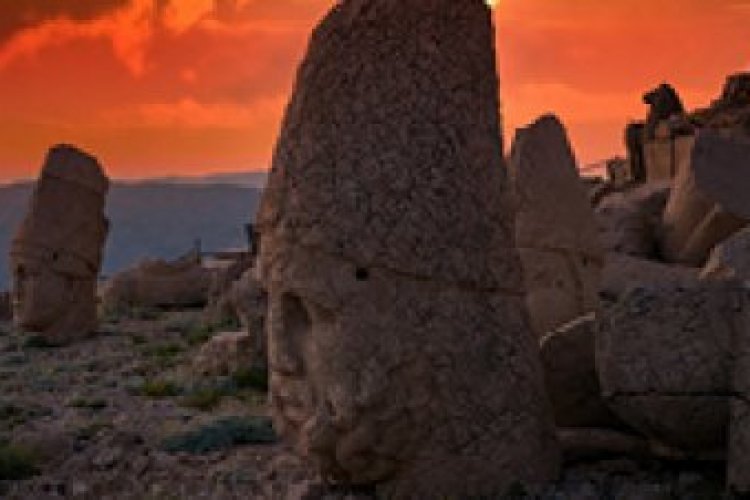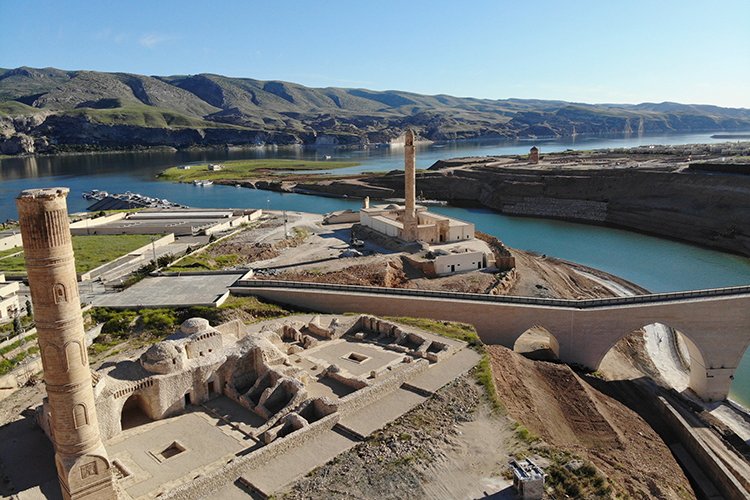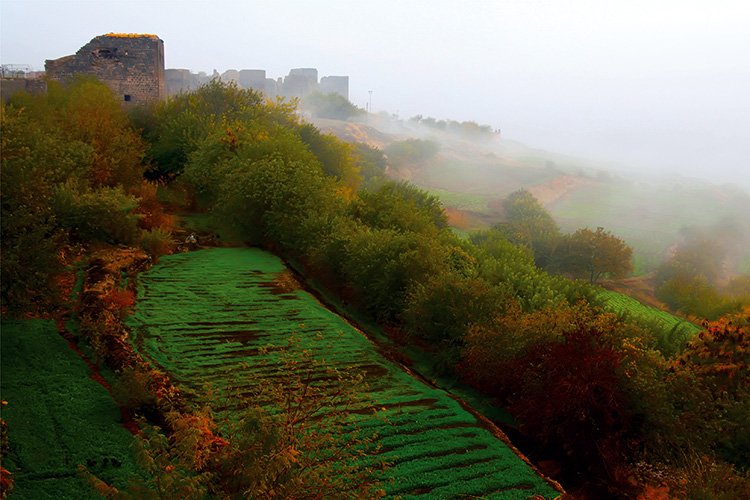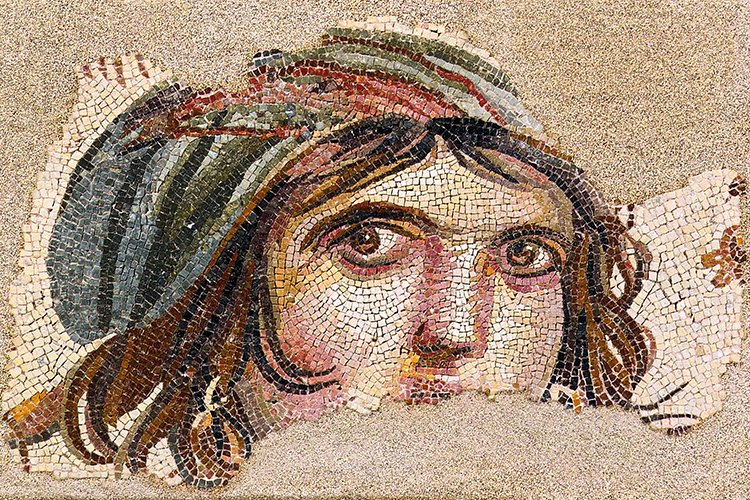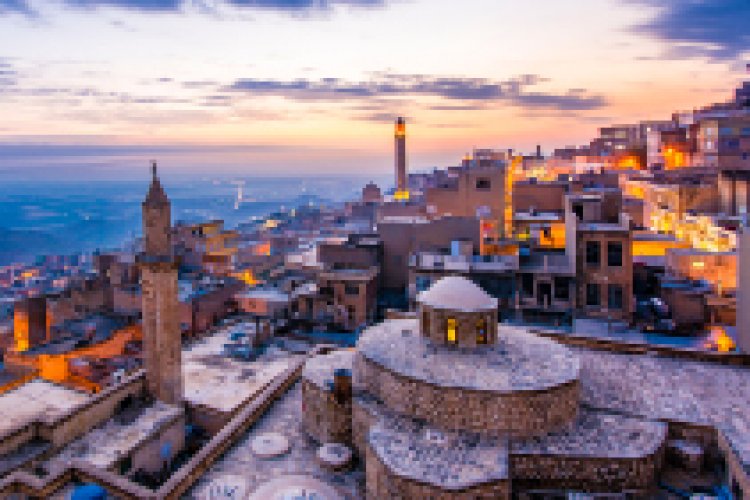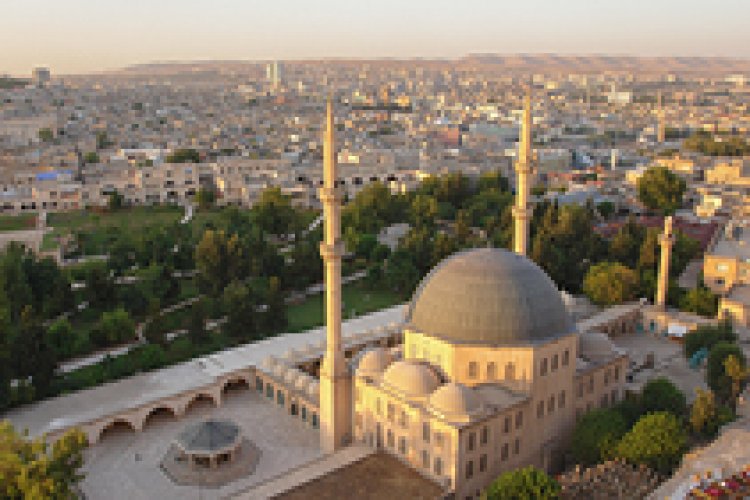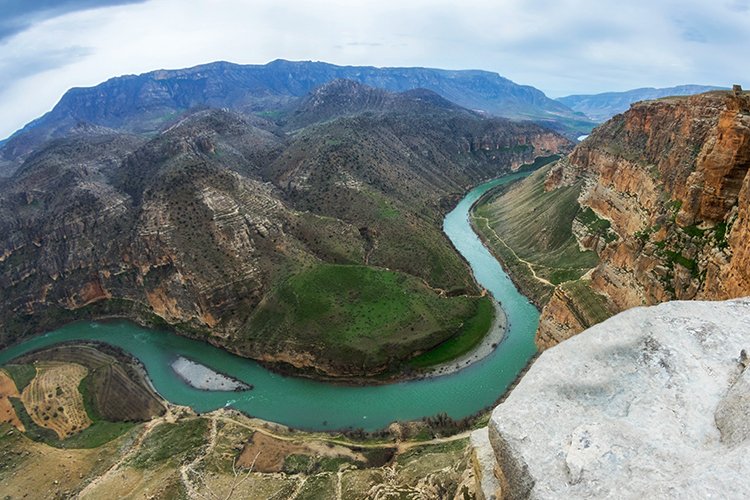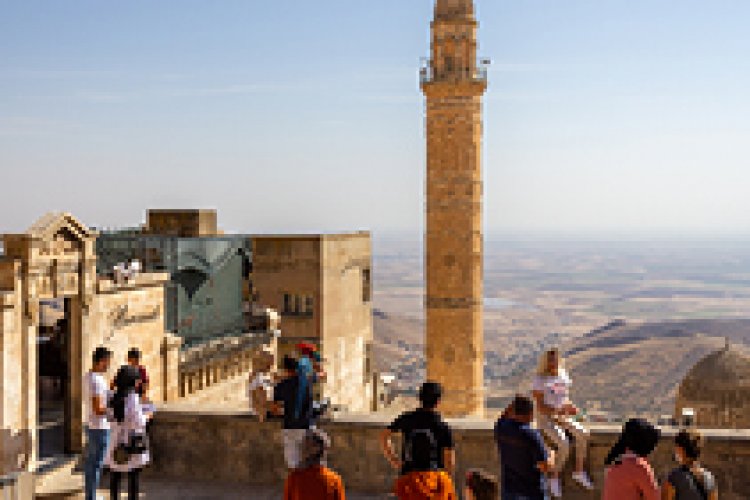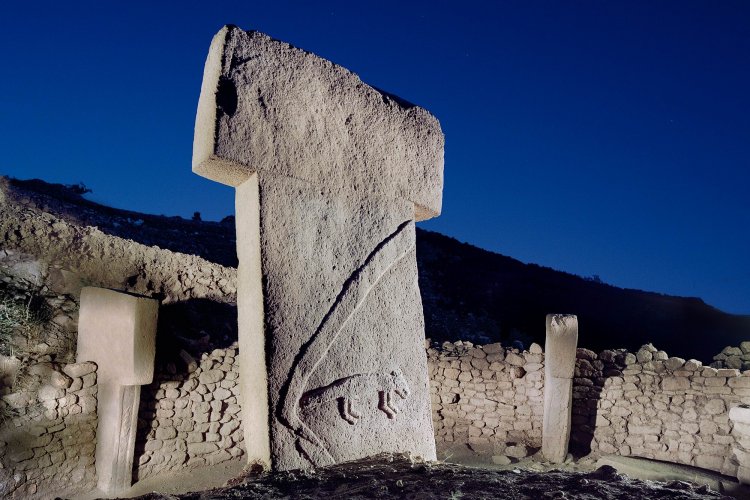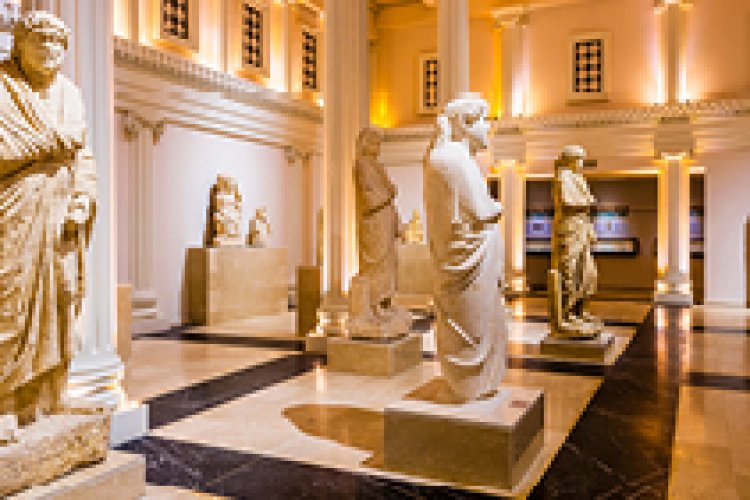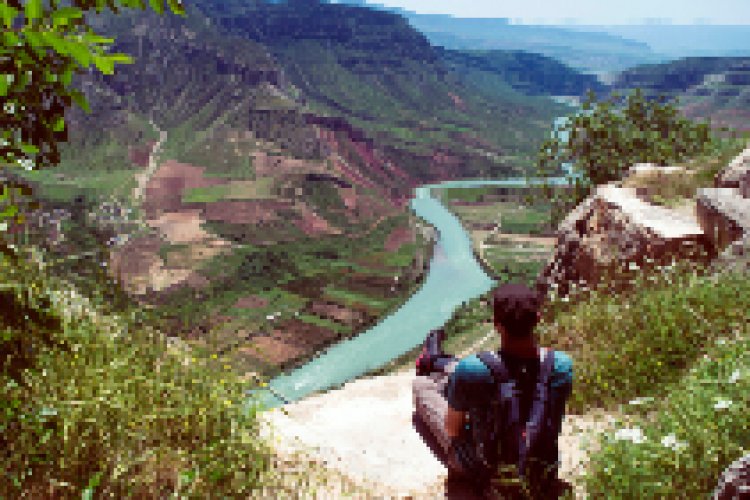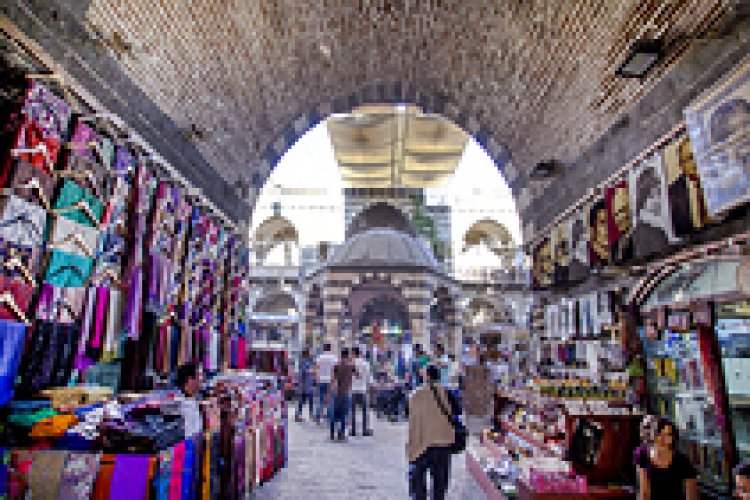Routes
Search Results
Adiyaman 2-Day Trip Route
In addition to the Adiyaman 1-day route, all the attractions in the Mount Nemrut National Park are visited on this route. Perre Ancient City, 5 km from Adiyaman city center, is actually a necropolis area of gigantic size. There are walking paths in the city and information at the entrance. There is a fee for visiting the city. There is a Roman Fountain, which is still in use today, in the Orenli Village, about 1 km ahead of the Perre Ancient City. It is recommended to stop at this fountain and have a photo taken and wash your face with freezing cold water. Mount Nemrut National Park is within the borders of Kahta county. On the way to Kahta, if desired, you can turn to the direction of Samsat and one of the companions of Muhammad, His Holiness Safvan B. Muattal’s Delubrum can be visited. The last center where you can eat and shop before entering the national park is the town center of Kahta. Eating and drinking opportunities in the national park are limited.... More »
Adiyaman City Tour
This route is a route that includes Adiyaman city center, Old Besni and the Euphrates riverside. There are very few places to visit in Adiyaman city center. Adiyaman Museum is a very comprehensive museum where you can see the ruins of many archaeological sites and ancient cities that have been submerged under the waters of the Ataturk Dam, and where you can see the "Golden Apple" award given to the Mount Nemrut National Park, which was declared a UNESCO World Cultural Heritage in 1987. Adiyaman Castle, which is a very beautiful city park today, Ulu Mosque, Old Palace Mosque and Adiyaman Syriac Metropolitan Municipality are other main attractions to visit in the city center. Oturakci bazaar is a very suitable place for shopping and making smalla talk with the local people. You can visit Adiyaman Syriac Metropolitanate and take photos and get information about Syriac culture and faith from the staff at the church (Please ask permission to take photos, be quiet... More »
Anabasis-The Return of Tens of Thousands Walking Route
Our route, which is named after Xenophon’s book Anabasis (translated in Turkish as The Return of the Tens of Thousands), offers you the unique beauties of the Tigris River and Gabar Mountain slopes, one of the places where the Hellenes had the most difficulty. This route consists of 4 different stages. In the first stage, you will discover the place where you can watch the unique view of the Tigris while walking to the Churches Mountain in Gabar Mountain from the side of the Tigris River and visiting the Churches in the two villages. In the second stage, you can visit the ruins of Finik and see the Finik castle, cave houses, cisterns and aqueducts, which are known to have been built during the Parthian period, and then you can see the madrasa and old settlements of Feqiye Teyran, the master of birds and nature. In the third stage of our route, we visit an old settlement, formerly known as Zêwê, where life is established in the caves. You can visit the old... More »
Batman City Tour
The most valuable historical and cultural destination of Batman is undoubtedly Hasankeyf. The establishment of Hasankeyf Castle is around 4th century AC, according to the available information. The castle, which was taken from the Byzantine Empire by the Umayyads in 639, has hosted the Abbasids, Hamdanis, Mervanis, Artuqids and the Ottoman Empire since that date. Hasankeyf, which had the brightest period of its history during the Artuqids period, has hosted many cultures for hundreds of centuries and has been the capital of tolerance as well as of civilization. In the context of its history and cultural tourism values, Hasankeyf is one of the most important touristic destinations in the Mesopotamian region. As it is known, the restoration of the Hasankeyf Castle has been completed, and the historical structures that may be damaged by the dam construction have been moved to their new places within the scope of the works carried out to ensure that the Ilisu Dam, whose construction has... More »
Beit-Zabde Culture and Faith Route
The first of the routes is called the Beit-Zabde Faith and Culture Route. This route, which covers the West of the Tigris, a part of the Botan region and a part of the Turabdin-Tor region, which used to be called Beyt-Zabde, covers our two counties on the silk road, Idil and Cizre. Within the scope of this route, our first destination is Kiwax/Cave village, an old Yazidi settlement. It is seen that the old houses in this village are made of caves or have a connection with the caves. No one lives in this village yet. Kiwax village offers a mystical atmosphere that fascinates visitors with its different tomb structures and stone houses. After Kiwax village, you can visit the churches in Sare, Oguntuk and Haberli villages where Syriac people live, and you can take a small tour in the village. After that, the Virgin Mary Church in Idil Center is worth seeing. Then, by going to Cizre, after visiting Noah's Delubrum, Red Madrasa, Grand Mosque, Mem û Zin Delubrum, Abdaliye Madrasa, Cizre castle,... More »
Botan Valley Ancient Walking Path
Aqaba means a man-made steep, difficult pass. It is estimated that the Aqaba Path, which is one of the three such gateways in the world, was built during the Assyrian times. Some of the original stone pavements on the ground of the path that starts from the Botan River and climbs a steep cliff to Siirt are still remaining. The highest point of the path is 910 meters above sea level and the lowest point is 620 meters above sea level. There is no water source on the Aqaba Path, which is 6.2 km long and has a "medium" difficulty level. The walking path, which starts on the road leading to Mir Yakup Monastery, proceeds on a thin but distinct path and reaches a rift that overlooks the Botan Valley. A unique view of the valley emerges along the narrow passage that begins to descend after crossing the breach. The stone pavements of the Aqaba Path, which is estimated to have been built by the Assyrians thousands of years ago, are revealed especially after descending... More »
Botan Valley Aqaba Walking Path
Aqaba means a man-made steep, difficult pass. It is estimated that the Aqaba Path, which is one of the three such gateways in the world, was built during the Assyrian times. Some of the original stone pavements on the ground of the path that starts from the Botan River and climbs a steep cliff to Siirt are still remaining. The highest point of the path is 910 meters above sea level and the lowest point is 620 meters above sea level. There is no water source on the Aqaba Path, which is 6.2 km long and has a "medium" difficulty level.
The walking path, which starts on the road leading to Mir Yakup Monastery, proceeds on a thin but distinct path and reaches a rift that overlooks the Botan Valley. A unique view of the valley emerges along the narrow passage that begins to descend after crossing the breach. The stone pavements of the Aqaba Path, which is estimated to have been built by the Assyrians thousands of years ago, are revealed especially after descending... More »
Botan Valley Peak Walking Path
The path, which starts 300 meters from the Ancient Path, turns left after reaching Gokcebag Town and climbs the 1180-meter-high hill, which is the highest point of the Botan Valley within the project area. This climb, made from a thin, but very distinct path, reveals a magnificent view of the Botan Valley. The part of the walking path up to Gokcebag, which is 10 km long round-trip, is in the "medium" difficulty level, and the part up to the top after this is in the "advanced" difficulty level due to its steep slope. There is no water source on the walking path. The walking path starts from a point that overlooks the Botan Valley on the Siirt-Eruh road. While the route rises slowly in the sparse forest, Gokcebag town remains at the bottom. When you reach the highest point on the northern slope of the Botan Valley, a magnificent view awaits you. There is a weak reception from all cell phone lines among the entire walking path. Still, the destination where... More »
Diyarbakir 2-Day Trip Route
In addition to the first day's Surici route, this route is a route that requires a walk around the Diyarbakir Walls, which is the second longest city wall structure in the world after the Great Wall of China. Diyarbakir Walls were declared a World Cultural Heritage by UNESCO in 2015. It has been preserved from the 4th century BC, the period in which it was built, to the present day and has reached in a very solid state. Diyarbakir Walls is a structure that has always managed to survive in the Roman, Byzantine, Arab, Turkish-Islamic, Seljuk and Ottoman periods and has reached the present day. The total length of the walls is 5.5 km, and 82 bastions and the walls are connected to each other. The most famous of these are Evli Beden (Ulu Beyden), Yedi Kardes and Keci (Kici) bastions. The bastions contain wards, cellars, cisterns and warehouses. There are inscriptions belonging to various states from the Romans to the Ottomans on the walls of the Outer Castle... More »
Diyarbakir 3-Day Trip Route
After two days spent in the city with urban routes, it is a very beautiful route full of history, culture and gastronomy outside the city. The first destination of the route is Devegecidi Bridge, which is an Artuqid Bridge. It is about 350-400 meters to the left of the main road. Egil Prophet Tombs, on the other hand, is a very impressive place with its landscaping and its position overlooking the Tigris River. It is possible to take a walk by the graves, watch the view of the Tigris, watch the Assyrian King Tombs from above, and have a picnic in specially designated areas. The next destination is Egil Castle. The castle, which is built on a very steep hill full of cliffs, can be reached by walking. There is an Assyrian relief and a cuneiform inscription at the top of the descent to the edge of the dam. Then it goes down to the edge of the dam lake. There are places to eat and drink and boats that take you to the Assyrian King's Tombs and tours along the... More »
Diyarbakir 4-Day Trip Route
It is the history, archaeology, local experience and nature route that can be done on the 4th day in Diyarbakir, after two days in the city, one day in Egil and Ergani. The only place to stop and see on the way is Ceper Inn, the ruins of a Seljuk caravanserai. Birkleyn water is one of the branches of the Tigris River and is on the Diyarbakir - Bingol highway. The cave is about 300 meters from the main road. Assyrian Kings I. Tiglat Pilaser and Salmanassar came this far during their Northern Mesopotamian expeditions and had their reliefs and inscriptions made on the walls of these caves, indicating that the world came to an end because the Tigris River ended. It is recommended not to enter the cave, as the amount of water will be high in the spring. In summer, bring your shorts or swimsuit with you. If you want to go further into the cave, it is recommended to take a head lamp with you. There is another giant cave, which can be reached by climbing the rocks,... More »
Diyarbakir City Tour
2015 yılında Dünya Kültür Mirası Listesine alınan Diyarbakır Surları ve Hevsel Bahçeleri bölgesinde sur içinde kalan ve tarihi Diyarbakır'a ait tüm cazibe noktalarını görebileceğiniz, gezebileceğiniz, fotoğraflayabileceğiniz ve yiyip-içip alışveriş yapabileceğiniz kent rotasıdır. Bu rotayı yürümek bütün günü alır. Yöre insanı ile bol bol sohbet edip onlarla iletişime geçebileceğiniz muhteşem bir rotadır. Çin seddinden sonra dünyanın en uzun duvar yapısı olan Diyarbakır Surlarının içini en ince ayrıntısına kadar tecrübe etme imkanı sunar.
More »From Hittites To Kommagene: Gaziantep, Adiyaman
Beginning with the Old Antep city tour and continuing with the Yesemek Stone workshop, the first known open-air sculpture workshop in history, surrounded by an emerald green lake on three sides and steep rocky hills surrounding it, Rumkale, a wonder of nature and human beings, continuing with the Halfeti boat tour, to the land of black rose, where stone architecture houses, mosques are hidden under water, to the roads hosting various civilizations leading to the Nemrut National Park... Our route traces the two great empires in the region... We continue our route which begins with two important settlements of the glorious Hittite Empire, Yesemek, the first open-air sculpture workshop in history, and an important royal city Tilmen, with Gaziantep bazaars. In the bazaars, we can't take our eyes off the kerchiefs that looks like they came out of Hittite reliefs (you should definitely try one of these colorful kerchiefs). From the old city to the Zeugma Mosaic... More »
Gaziantep 2-Day Trip Route
It is a tour that can be done along the Euphrates river outside the city center of Gaziantep, after the city route on the first day. Karkamis, the historical site having the same name for thousands of years, is an important Hittite city. Since it is located right on the Syrian border, on the west side of the point where the Euphrates River crosses into Syria, it would be better to check whether it is open to visitors and set off accordingly. Another destination of the route is Zeugma, which is located on the west side of the Euphrates and where the mosaics exhibited in the Zeugma Archaeological Museum were unearthed. It is possible to see Roman villas, floor mosaics and wall paintings in Zeugma, some of which are now under the waters of the Birecik Dam. This was one of the most important trade centers of antiquity and it controlled the trade and crossings on the Euphrates. It was one of the most important cities of the Seleucid Kingdom and Rome. The next... More »
Gaziantep 3-Day Trip Route
Gaziantep city center is the history, nature and gastronomy route that can be made on the 3rd day after the Euphrates route. The first destination of the route is a 4000-year-old settlement located on the ancient roads connecting Syria to Anatolia in the middle of the Islahiye lowland. It is also very suitable for bird watching as it is surrounded by swamps. The next stop of the route is Yesemek Open Air Museum. Yesemek is the largest known sculpture workshop in the ancient Near East. The quarry was first used in the Hittite Empire period (15-12th century BC) and later in the Late Hittite period (9-8th century BC) by the Sam'al Kingdom. Traces of the quarry where the rocks were extracted can still be seen in the upper part of the hill. Although the number of statues exceeds 300, it is believed that many more are under the ground. The last destination of the route is Ravanda Castle, which is a medieval castle. Precise information about Ravanda Castle, which... More »
Gaziantep City Tour
This route, namely the Culture Route, covers all the history, culture and shopping spots in Gaziantep city center, allows you to take lots of photos, tour the historical streets of Antep, shop in its inns, make small talk with the local people, where you can live to the marrow. The Culture Route, which starts from Antep Castle, continues with historical bazaars and inns, ends with Sehrekustu mansions to Kastels and finally at Sahinbey National Struggle Museum, offers its guests a great cultural feast. After the National Struggle Museum, you can go to Bey Neighbourhood, either by car or walking. If you have time, in addition to this route, Gaziantep Panorama Museum, Islamic Science History Museum and Zeugma Mosaic Museum can be visited.
More »Gorumlu Kelehya Walking Route
Gorumllu town is a place where people prefer when they are overwhelmed by the heat and wan to take a breathe. In this town, which is hidden among the trees, you can see the Tellioglu Summer Palace, the old Gorumlu Church, the White Stone Bridge, and drink the cool waters from the Kelahe spring. By the way, keep this between us, the fruits of Gorumlu have always been popular, especially the fig.
More »Grand Mesopotamia Tour
It is a route minimum of 9 days, where you can explore Mesopotamia with its history, culture, nature and gastronomy. The route starts in the historical inns, baths, bazaars and narrow stone streets of Old Antep. After a day of wondering what to eat and buy, it continues with the world's largest mosaic museum, namely the Zeugma Archaeological Museum. The next destination of the route is the Euphrates. Here you visit Zeugma (Belkis) Archaeological Site, where the unique mosaics you see in the museum were unearthed. Afterwards, you will cross to the east of the Euphrates and arrive in Birecik, which is famous for its bald ibis, eggplant kebab and knafeh. The last 205 of the extinct bald ibis birds around the world can be seen at the Bald Ibis Production Station in Birecik. Halfeti, which was mostly submerged by the Birecik Dam Lake in 1998, is our next destination. From here, you can go to Rumkale with boat tours, watch birds and eat on the shore of Halfeti.... More »
Hell Brook - Tigris River Walking Route
Looking at the Hell Creek from Yarbasi Village, formerly known as Esfis/Hestpist, we see the breathtaking view, the dance of the fish in the creek, and the village settlements carved into the rocks. Then, as we head to Sulak (Bafe) Village, you can rest your soul in Tigris’ serenity and see the Bafe castle and the castle of the folk hero Elo Dino, and then see Hendekkoy, known as the old settlement of the old Idil, and then complete your walk in the village of Cizre/Ulas.
More »Kilis City Tour
This is a one-day route and it includes the attraction centers of Kilis city center and its surroundings. With the outbreak of the Syrian War, Kilis has turned into a city where more Syrians live than its own locals. For this reason, you have the chance to experience many details about Aleppo without going to Aleppo. Located on the left side of the road at the entrance of the city, Oylum Hoyuk is ancient Kilis and its excavations are still continuing. Here you can see the basilica with mosaics. The city center, on the other hand, offers a visually rich walking route where you can see delubrums, mosques, baths, mansions, old narrow streets, traditional olive oil squeezing workshops and the museum. Just outside the city, Kuru Kastel is a must-see frequent destination which you need to say "I have been there, too". This is the place, namely kuru kastel, mentioned in the famous Kilis folk song “Karanfil Deste Gider”. Kastel means fountain. Another frequent destination... More »
Mardin 2-Day Trip Route
In addition to the city route along the 1st Street in Old Mardin, the second day is a route that starts in the city of Mardin and extends to the Deyr-ul Zaferan Monastery and the Ancient City of Dara. It starts in front of the Mardin Museum and goes down to the 2nd Street along the narrow Mardin streets. On this route, Artuklu Mosque, Latifiye Mosque and Emuneddin Mosque, one of the first social complexes of Anatolia, are important places to see and spend time at. The green courtyard of Emineddun Complex will provide you with a great relief in the heat of Mardin. The route can be continued by walking up to this point, after descending to the 2nd street, you can go to Deyr-ul Zaferan and from there to the ancient city of Dara by car. There is a fee for visiting Deyul Zaferan Monastery, and a guide service is provided and a narrative presentation is made. The monastery has a very nice souvenir shop and cafe. Again in the ancient city of Dara, there are places... More »
Mardin 3-Day Trip Route
It is a tour route consisting of Mardin city center and Savur, the greenest county of Mardin after Dara Ancient City. Although Savur is a rather small town, it is one of the most interesting tourism attractions of Mardin, historically, culturally and naturally. It is an ideal route to spend a full day with the unspoiled historical urban atmosphere, the Savur river flowing in summer and winter, and the unique culture of Turkish-Kurdish-Arab-Syriac cultures living together in peace. Haci Abdullah Bey Mansion, Savur Castle, Aziz Sancar House, Savur street and houses are places of unique beauty to see and spend time in in the county center. The Savur Stream side, which is full of poplar, willow, plum and various fruit trees, is a region where you can eat, walk and see historical laundries that you cannot see anywhere else in Turkey. Killit (Dereici) Village, which is 10 km away from Savur town center, is an Assyrian village and almost like a movie set with its... More »
Mardin 4-Day Trip Route
This tour route, which includes trips to Midyat City Center, Savur, Midyat and Mor Gabriel Monastery, allows you to gain many experiences, especially shopping. The Muslim Quarter Estel and the Christian Quarter Midyat in Midyat are places of attraction with different structures and textures at the two ends of the city. Churches, mosques, mansions, inns, bazaars can be visited and plenty of shopping can be done in the city center.
A visit to the Mor Gabriel Monastery is a must for this tour. If desired, the villages of Hah (Anitli), Zaz (Izbirak), Aynverd (Gulgoze), Salah (Baristepe) and Kferze (Altintas) can also be visited to take photos. It is possible to continue the route with Hasankeyf.
Mardin 5-Day Trip Route
It is a 5-day Mardin city route to which Nusaybin is added in addition to the first 4-day route. While traveling from Midyat to Nusaybin, Beyazsu, the only fresh water of the region, is one of the rare beauties that must be seen, gone into and eaten at. Ice-cold water allows you to cool off in the heat of Mesopotamia. In the city center of Nusaybin, the most important attraction point is Inanc Park. This is a park where mosques, delubrums and churches are located together. The Mor Yakup Monastery within the park is one of the most important historical monuments to be seen in Nusaybin. The person responsible for the monastery will both show you the monastery and inform you about its history and importance. Excavations continue in the monastery garden. Another important place to be seen in the city center is the house of Musa Anter, a Kurdish intellectual, which has been turned into a museum. On the other hand, Nusaybin is a city located at the zero point... More »
Mardin City Tour
It is a full route that crosses the historical Mardin city center from one end to the other, where you can experience all the history, culture and shopping destinations in the city, where you can make small talk with the local people, and tour the city in the shade of the narrow Mardin streets. It is recommended to take a car from Kasimiye Medresesi, which is the beginning of the route, to Kirklar Church, and to walk up to the end of the following route. Since the temperature in Mardin is very high, it is recommended not to take this route at noon when the weather is extremely hot.
More »Mystery of the Massive Stones
The roads starting from the Sanliurfa City Museum, which is located within the walls and known as the Mahmudoglu Tower, and continuing with the 12,000-year-old Gobeklitepe, which is home to the oldest temple structures in the world, then leading to the first university of history, Harran, which draws attention with its conical domed houses and different architecture, to Sogmatara, to Nemrut, knowns as the 8th wonder of the world, to Cendere, to Old Kahta, and to Arsemia... On this tour route, we will trace the giant statues created by mankind over thousands of years. This workshop, which started to be sculpted between the 14th century BC and the 7th century BC, that is, 3300 years ago, is the largest quarry and sculpture workshop in the Middle East, Yesemek. The workshop, where the local people, namely the Hurrians, worked, was put into operation in the second half of the 2nd millennium BC, when the region came under Hittite rule, during the reign of the... More »
On the Path of Divine Love
A divine journey covering Mevlana, a poet of unlimited tolerance, who forgives and loves, and a sufi, scholar reverend, who summarized his life with the words "I was raw, cooked, and then burned”; Haji Bektash Veli; a love story between Mem and Zîn which started as being "metaphorical" end then turned into “divine" and “true”; Ahmet Xane, who pays tribute to Muhammad and the four caliphates and tells about Miraj (Muhammad’s ascent to heaven) and request for intercession; Veysel Karani, who has been desparately in love with Muhammad for his entire life. A divine journey from Mevlana, the pioneer of the Mevlevi in Mysticism, to Shams Tabrizi, from Diyarbakir Grand Mosque to the Prophet's Tombs in Egil, from Veysel Karani to Van, to Ahmede Xane and İshak Pasha Palaces in Agri.
More »On the Rail of of Noah - Pursuit of Spirit Route
In many historical sources and the Holy Quran, it is written that the ship settled on the Judi / Judi / Kardu mountains after Noah’s Flood. The place where the ship sits is named Sefine (ship). Until the 1980s, the Sefine region was visited every July of the year for worshipping. In July, a few people used to go to light a huge fire and announce that the visit to Sefine had started. Sefine is a place that can be seen from both the south (Silopi, Cizre, Iraq, etc.) and north (Sirnak, Uludere, etc.) of Sirnak (2030 meters of altitude). In order to meet the drinking water need of the people who come there, the snow that has not yet melted used to be filled into the cisterns there... Animals used to be sacrificed, people used to stay there for weeks and worship. The visitors include all the Muslims, Chaldeans, Nestorians, Jews, Assyrians, Armenians. There is a belief that you are considered a pilgrim when you visit the place, which is sacred to three monotheistic... More »
On the Trail of Art and Science: Artuqids
Artuqids are quiet and proud guests of the Middle Ages. After a unique period at the pinnacle of Art and Science, centuries of silence with the invasion of the Mongols. Our route invites you to see this extraordinary story. Our journey, which started with the unique Great Mosque with its curved minaret in Harput, Elazig, continues with Diyarbakir. Artuklu Palace, Walls (Ulubeden and Yedikardesler Bastions), Zinciriye and Mesudiye Madrasa, On Gozlu Bridge, Silvan Grand Mosque, Mardin and Kiziltepe Grand Mosques, Eminuddin Complex, the first social complex in Anatolia, Mardin Kasimiye Madrasa, Hasankeyf, Malabadi Bridge, plastic human figures and animal-plant reliefs on the walls and bridges, automatons made by Al-Jazari in the Artuqid Palaces allow you to rediscover this extraordinary civilization.
More »On the Trail of the Mosaics
This route, where the most beautiful and valuable mosaics of the world will be traced, covers the cities of Adana, Antakya, Gaziantep and Sanliurfa. You will be able to see the most valuable mosaics of the ancient world in Adana Archaeology Museum (formerly known as Misis Mosaic Museum), Hatay Museum, Zeugma Mosaic Museum, Belkıs Archaeological Site where Belkis Mosaics were unearthed, and Haleplibahce Mosaic Museum, and you will be able to feel that colorful and rich world with all your senses. On this tour, you will be accompanied by the beautiful gypsy girl, zebras, African-American children, Amazon queens, as well as the lovely statue of King Suppiluluima and the statue of Mars, which seems to reach out and touch you at any moment. This route will also give you the opportunity to see the ancient streets, colorful bazaars and taste the unique flavors of Adana, Antakya, Gaziantep and Sanliurfa.
More »On the Trail of the Wheat: Sanliurfa, Diyarbakir, Elazig, Malatya
Milestones of mankind will be visited on the tour route, which is planned to last for five days. On our route, following the traces of wheat in fertile lands, we will go all the way down ftom Gobeklitepe with its 12,000-year history, to Harran, which draws attention with its conical domed houses and different architecture made of wild wheat still grown on the feet of Karacadag, which is the origin of all grains, then to Sogmatara where Moses’ well, which, according to the belief, is the well Moses helped His Holiness Shuayip’s daughters water their herds, is believed to be located, then to Cayonu, the archaeology center that best reflects man's transition to a settled order, then to Hazar Lake, which is Turkey's deepest lake and known as the secret sea of the East, then from Elazig to Malatya museum and then to Aslantepe Archaeological Site, where the first minimum wage is matched with a bowl of wheat, and to the journey of a wheat kernel… Following the... More »
Reverse Tulip Culture and Nature Route
The inverted tulip, which grows at high altitudes, grows in late April and early May and offers a very beautiful visual feast. This route starts with Kasrik Pass, which divides Gabar and Cudi Mountains into two. Kasrik Pass has interesting structures with its geological formation. After Kasrik, you can taste Tahini made in historical water mills in Kumcati County and see how it is made. Afterwards, you can feel the highland atmosphere in the city center of Sirnak and have tea in the city center with its hospitable people and listen to the story of Sirnak. After Sirnak, and after you drink natural terebinth coffee in Balveren County and take a rest, you can see the Chaldean settlement Onbudak Village and Old Hilal Villages in Senoba with unique views. In addition, after Hilal, you can visit the Reverse Tulip Gardens, which grow at high altitudes in late April and early May and offer a very beautiful visual feast. Afterwards, the road divides into two (Uludere... More »
Sanliurfa 2-Day Trip Route
It is an alternative city route to the first day route. The route starts from Bey Gate, passes through Urfa streets, historical bazaars, inns and shops and ends at Bey Gate. The next destination is Gobekli Tepe, the oldest monumental temple in the world, located approximately 20 km from the city. It is recommended to walk around here either in the early hours or in the evening when the air is cool. Gobekli Tepe, which puts the history of civilization back about 7000 years and changed the archaeological theories we know, is a journey where people will seek answers to the questions of what am I, where did I come from and search for their ancestors. Our last route on this tour is Karahantepe, which is claimed to be the twin of Göbekli Tepe and full of T-columns just like it, and constitutes an important new tourist destination for Şanlıurfa.
More »Sanliurfa 3-Day Trip Route
After the two-day Sanliurfa City Center route, it is the route that includes most of the Harran and Tek Tek Mountains National Park. Harran is an Assyrian name meaning the crossroads and was the last capital of the Assyrian Empire. You can see the ruins, observatory, madrasa, palace in Harran county center and visit the dome-roofed houses exclusive to Harran. A large bath structure was unearthed during the excavations carried out in 2015, and this bath has numerous interesting details. You can get on a camel in this historical city on the roads of trade caravans. Don't forget to drink mirra, an element of Arab culture, and listen to the story of mirra culture in Harran. The second destination of the route is the Bazda Caves, which were handmade by humans. This place was used as a quarry in the construction of the city of Harran, and the stones cut from here were transported to Harran and city walls, palaces, baths, mosques, and observatory to be built. The... More »
Sanliurfa 4-Day Trip Route
It is the only route to the east of the province after Sanliurfa City Centre, Gobekli Tepe and Harran and its vicinity. This route passes through the northern end of Tek Tek Mountains National Park. The most important places to visit here are Karahan Tepe, which we can call the twin of Gobekli Tepe, where traces of prehistoric settlements such as Gobekli Tepe can be found, but not yet excavated. Here, as in Gobekli Tepe, it is possible to see smaller T-pillars. Sanem caves is a village with various architectural structures carved into the rocks. It is thought that the large three-storey building found here and carved into the rock was a palace and a monastery. Another visitor center, Cimdin Castle, is a defense castle from the Eyyubids, surrounded by dykes. Since it is on the caravan routes, it also served as an important logistics center. The other two destinations of the route are His Holiness Eyyub Nebi Delubrum an Viransehir city center. In Viranşehir,... More »
Sanliurfa 5-Day Trip Route
It is a route to take place entirely along the Euphrates after Sanliurfa city centre, Gobekli Tepe, Harran and its surroundings, Viransehir and its surroundings. Located right on the side of the Euphrates, Birecik is such a paradise with its history, culture, wildlife and delicious food. In this city, you can enjoy the Euphrates river to the fullest. If you come early in the morning, do not forget to eat chickpea sandwich. It is a super Birecik breakfast in which chickpeas cooked in a pan in a wood oven are wrapped with various spices and peppers and enjoyed. Do not leave Birecik without eating eggplant kebab, especially if you are visiting during the summer months. The eggplants that grow in the region called Mezra in the south of Birecik and are harvested at the beginning of July are the most delicious eggplants that you can never get enough of. If you have any room left, do not forget to eat knafeh with ice cream in Birecik. In order to burn this much... More »
Sanliurfa City Center Route
The route starts at Sanliurfa Archeology Museum. Take a few hours to review the museum's rich archaeological collections, documenting the excavations and stories around Sanliurfa from prehistoric times to the present. Among the most interesting things on display are the "Urfa Man", which is considered the oldest statue in the world, and a replica of Göbeklitepe D Temple.
When you move towards the left part of the Archeology Park from the Sanliurfa Archaeology Museum, you will see a cliff full of caves. The history of the Kizilkoyun Rock Tombs, which consists of 59 caves, some of which have mosaic floors, dates back to the Oshroene (Edessa) Kingdom, the Roman Kingdom and the Byzantine period. Turn around and head towards the large domed building of the Haleplibahce Mosaic Museum, located in the southern part of the Archaeological Park, and take your time to admire the impressive mosaics of the kind that have not yet been uncovered around Sanliurfa. The... More »
Sanliurfa City Tour
It is an urban route that includes Sanliurfa Museum, the largest museum in Turkey, Haleplibahce Mosaic Museum, Balikligol Complex, Urfa Castle, historical bazaars, inns, old Urfa streets, mosques and churches..
More »Sanliurfa Craft Route
The craft path begins with the Bedendibi Art Street, which is located within the Old City Walls, very close to the City Museum. Here you will see a series of interconnected Ottoman-era buildings that host many small workshops producing a range of products including woodcarving, marbling, jewelery and calligraphy. Bedendibi Art Street ends with Urfa City Museum. Spend some time at the museum to discover the history and craft traditions of Sanliurfa. From the City Museum, turn right onto 1043 Street and follow this road for about three minutes; turn left and turn left at the first T-junction at 1017 Street. Proceed in a zig-zag pattern for a few minutes from the southwest, and you'll reach 58 Square. Here you can visit 11 Nisan Cafe to take a rest before continuing on your journey. The cafe is expected to be host customers in 2018-19. Follow 1014 Street and then Kazanci Bedih Street and continue descending southwest towards Mevlevihane Street.
Follow... More »
Sanliurfa Historical Center Route
Start your day early, when the weather is fine and the sun is not directly overhead yet. The route starts from Barutcu Inn, located in the Old Bazaar. The recently restored 18th-century Ottoman Inn, which is expected to be operational in 2018-2019, will bring together "the best of Urfa" in one place and will feature restaurants, cafes, specialty arts, crafts and local food shops when completed.
While wandering around Barutcu Inn, take some time to look at the rest of Sanliurfa's historic Old Bazaar. Among the most interesting ones of the labyrinth-shaped covered bazaars built during the Ottoman Period are Sipahi Rug Bazaar, Bedesten Textile Bazaar, Coppersmiths' Bazaar and isot pepper bazaar.
Before leaving the bazaar, stop by the Gumruk Inn having a nice atmospehere. This is a restored caravansary surrounded by locals drinking coffee all the time. Try mirra, a very strong and bitter local coffee, or try terebinth coffee, which... More »
Serefiye-Bertul Waterfall Walking Route
If you want to take a walk in touch with nature, swim under the waterfall in the shade of historical plane trees and stay alone with nature, this route is tailor-made for you...
More »Siirt City Tour
The history of Siirt, which was founded at the intersection of Upper Mesopotamian and Anatolian civilizations, dates back to 12 thousand years ago, to the beginning of the Neolithic period.
Siirt has a very old history in terms of heritage. As a result of the archaeological surveys, excavations and other scientific researches carried out in Siirt, being founded at the intersection of the Upper Mesopotamian and Anatolian civilizations, the history of Siirt dates back to 12.000 years ago, which is the beginning of the Neolithic Age, and it has been determined that settlements were seen in the Chalcolithic, Bronze and Iron Ages. With its natural beauties, historical artifacts, the treasure of the Southeast, which is worth seeing and waiting to be discovered, where His Holiness the Prophet Lover Veysel Karani, His Holiness Ismail Fakirullah, His Holiness the Companian Abdullah Bin Avf who is heralded with heaven, His Holiness Muhammad Bin Hanife,... More »
Sirnak City Tour
Finik Ruins, consists of an inner castle and an outer castle, which is located within the borders of today's Damlarca village of Guclukonak county. It is located on the northern side of the Tigris river, 12 km from the Cizre-Sirnak junction, on the upper part of the highway that leads to the current Guclukonak county. The remains of the walls in the outer castle extend in the north-south direction. The region is generally described as Finik and dominates the Tigris River and its Valley. The old settlements are spread over a wide area. The mosque, which is one of them, was established on the west side of the creek emerging from the rocks just ahead. A flat area was created with retaining walls on the western side of the stream. This area is on the north side of the mosque. There are also various ruins and caves on both slopes. Today, the mosque is on the wayside at the Guclukonak highway.
Reliefs such as kings and horse figures are found in Cudi Mountain,... More »
